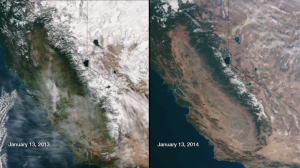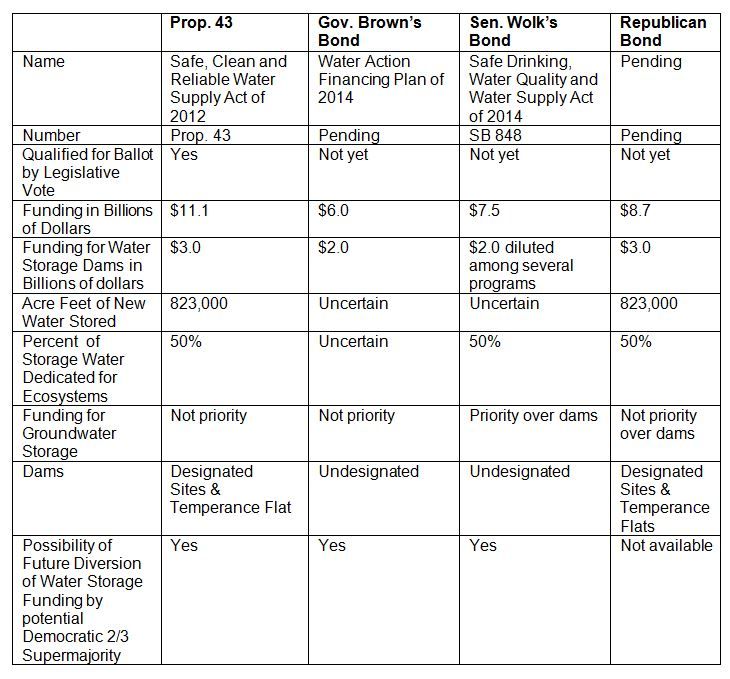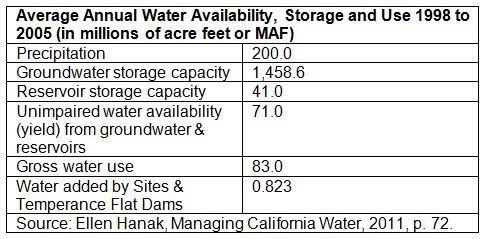$1 billion difference splits bond measures
by Wayne Lusvardi | August 11, 2014 4:22 pm
 It’s becoming clear the main difference between the four major water bonds[1] being floated is $1 billion.
It’s becoming clear the main difference between the four major water bonds[1] being floated is $1 billion.
The $1 billion is the difference between the $3 billion Republicans say is needed for water storage, and the $2 billion in the two Democratic plans.
The $3 billion amount for water storage is in the state Senate Republicans’ proposed $8.7 billion bond[2]. And it’s the number in Proposition 43[3], the $11.1 billion bond already on the November ballot, but which could be taken off and replaced with something else.
That’s why Republicans, and their farmer constituents, favor keeping Prop. 43 on the ballot if the Senate GOP’s version, or something like it, cannot be advanced.
By contrast, the Democrats’ two water bonds contain only $2 billion for water storage. They are Gov. Jerry Brown’s $6.0 billion[4] proposal and state Sen. Lois Wolk’s $7.5 billion water bill, SB848;[5] the latter places a priority on groundwater storage over dams.
It’s curious that normally frugal Republicans are willing to back the two most expensive bonds primarily because they contain that $3 billion for storage instead of $2 billion. State Sen. Anthony Canella[6], R-Ceres, told the Modesto Bee, “We have to build two reservoirs and $2 billion won’t build one. So what’s the point? Why put a bond on the ballot that produces no water?”
Below is a table to compare contending water bonds regarding the water storage issue:

Both Republican and Democratic proposals are intended to downsize the $11.1 billion Prop. 43 water bond. It contains $3 billion for storage and identified two new reservoir locations: the Sites Reservoir north of the Delta and the Temperance Flat Reservoir south of the Delta (see links below).
Republicans temporarily forced to endorse big bond
Prior to the Republicans’ $8.7 billion water bond proposal, the Fresno Bee[7] reported that 150 farmers signed a letter on Aug. 6 to California legislators supporting the big $11.1 billion bond because it contains $3 billion for storage.
Said Assembly Leader Connie Conway[8], R-Tulare, “You can talk about restoration of the Delta, you can talk about recycling, you can talk about all the things you want to do. That takes water!”
Reservoirs only provide half of water use each year
Many Californians are under the wrong assumption that the state gets most of its water from reservoirs. Reservoir storage only makes up about half of annual water use, as shown in table below (41 millions of acre feet out of 83 MAF). Presently, the only way California can survive droughts is to shift to groundwater and curtail water for farmers with junior water rights.
The proposed Sites Reservoir[9] is estimated to cost $2.3 to $3.2 billion for 470 to 640 thousand acre-feet of net usable water each year (actual total storage is much higher).
Temperance Flat[10] is estimated to cost $1.0 to $2.0 billion and yield 183,000 acre-feet of net usable water each year.
The proposed Sites and Temperance Flat Reservoirs combined would cost about $4.4 to $5.2 billion. But they would meet only about 1 percent to the total gross annual water use in California (823,000 out of 83 million acre feet MAF).

However, the 823,000 acre-feet of water from these two new reservoirs would backfill 27 percent of the 3 million acre-feet of water per year diverted to fish runs and wildlife refuges since 1992[11].
If California’s unofficial drought policy demands that farmers with junior water rights curtail usage in droughts so everyone else can have enough water, additional farm water reservoir storage is something that voters might get behind no matter the size of the ultimate water bond.
- the four major water bonds: http://calwatchdog.com/2014/08/09/water-fight-now-its-four-bonds/
- $8.7 billion bond: http://www.latimes.com/local/political/la-me-pc-senate-gop-bond-20140808-story.html
- Proposition 43: http://ballotpedia.org/California_Proposition_43,_Water_Bond_(2014)
- 6.0 billion: http://gov.ca.gov/docs/The_Water_Action_Plan_Financing_Act_of_2014.pdf
- $7.5 billion water bill, SB848;: http://www.leginfo.ca.gov/pub/13-14/bill/sen/sb_0801-0850/sb_848_bill_20140703_amended_sen_v94.htm
- Sen. Anthony Canella: http://www.modbee.com/2014/08/06/3475423/our-view-gov-browns-water-bond.html?sp=/99/1641/#storylink=cpy
- Fresno Bee: http://www.fresnobee.com/2014/08/06/4057892/valley-officials-support-bigger.html
- Connie Conway: http://www.fresnobee.com/2014/08/06/4057892/valley-officials-support-bigger.html
- Sites Reservoir: http://www.water.ca.gov/storage/docs/NODOS%20Project%20Docs/Sites_FAQ.pdf
- Temperance Flat: http://www.water.ca.gov/storage/docs/USJ%20Project%20Docs/Temperance_FAQ.pdf
- 3 million acre-feet of water per year diverted to fish runs and wildlife refuges since 1992: http://www.sacbee.com/2014/08/01/6596658/viewpoints-groundwater-cant-be.html
Source URL: https://calwatchdog.com/2014/08/11/1-billion-difference-splits-bond-measures/